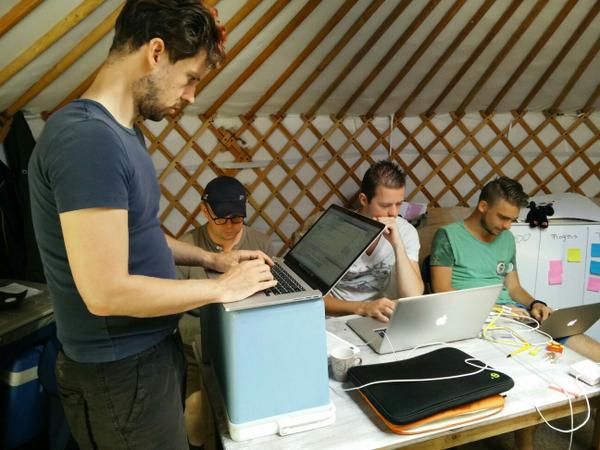
Thursday, August 27th 2015
After the breakfast and daily cross-team standup we moved to a smaller tent. It was announced to us that rain would be forthcoming for most of the day. Because we had a different table, I created a new setup, as a standing desk and Mitchel set up the Arduino inside a box, to make sure it couldn’t get wet.
Pretty soon after we got settled, the rain came drizzling down and didn’t really stop for most of the day.
To get a better feeling of where we were at in our plan (and to see how far we still had to go), we held a short standup.
To keep an eye on what we were doing we decided it might be a good idea to set up a scrum or kanban board. Because we felt there was a large likelihood of our team moving locations at a later time a digital board seemed more useful.
I suggested using a waffle board for our project.
Another part of the discussion was on how we could possibly improve the Arduino coding cycle, as it was quite slow-going. Jerry suggested that an emulator might be available, so code could be checked before sending it to the Arduino. Eventually we decided that it may be counter-productive to look into that, but to look into that at a later date (after WeCamp).
Despite the rain, we set to work enthusiastically. Unfortunately, there were some setbacks with the Arduino. One was understanding how the Arduino serial console worked. The main issue was making sure that the frequency set from the code and used in the console were the same.
Another thing that impeded on our progress was understanding the different layers that make up the Arduino software stack. The fact that various examples (either from the aRest library, the Arduino website itself or elsewhere online) used different layers. This send us on a bit of a wild goose chase through the C/C++ reference, the AVR libc and Arduino manual.
After some time of successful coding Mitchel ran into another problem. After some people jumping in to help, the cause was found to be the fact that the end of strings are marked with a NULL character. This meant the counting logic was of-by-one.
While all of this was going on, Jerry made great headway with his plugin architecture and the plugin to communicate with Slack and I had set up the ground work for the plugin that handled comunication with the Arduino.
We also managed to create a digital version of the sketch for our bot from the day before:

The longer the rain lasted, the colder it got in the tent, especially because one side was open. The TalkBack team was graceful enough to allow us to share their yurt. Supported by our coach, we moved our workstation to their tent. And there was much rejoicing.

After yet another lovely dinner I had several rather lengthy conversations with different people after which we did some more work. Before heading of to bed, all of the individual components were finished. All that was needed to have a minimum viable product was to integrate the individual components.